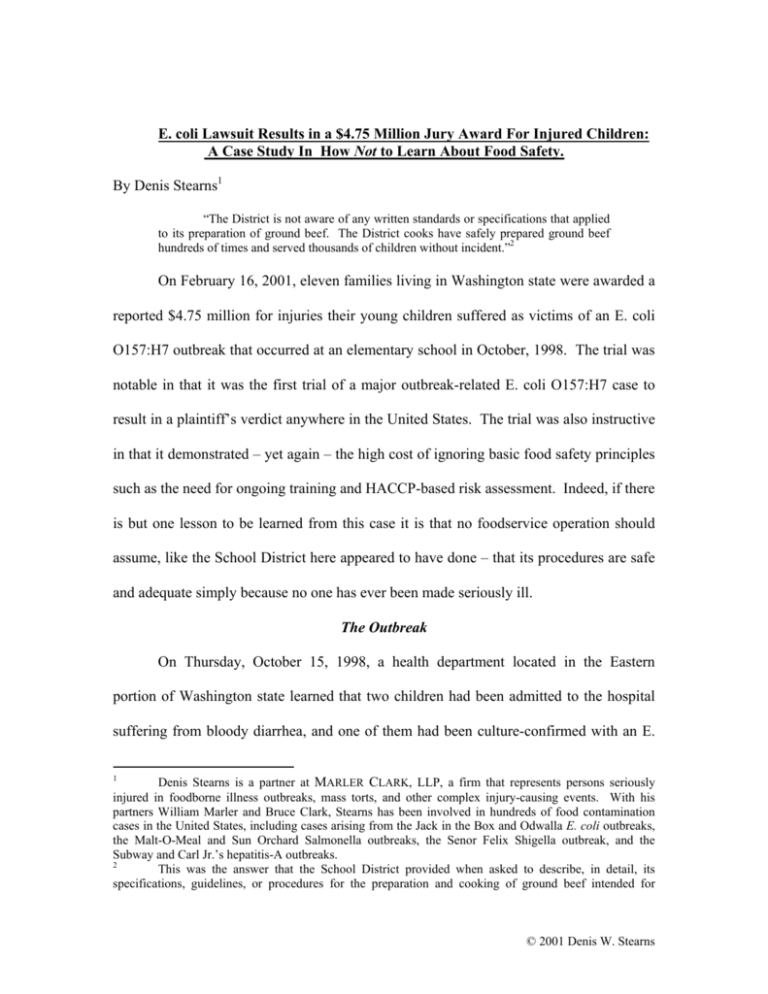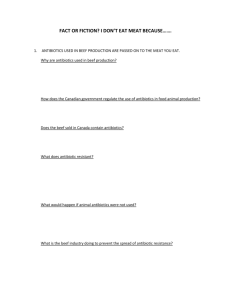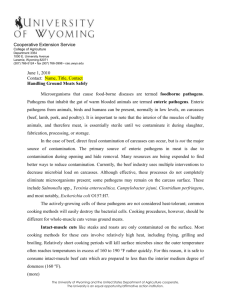E. coli Lawsuit Results in a $4.75 Million Jury Award
advertisement

E. coli Lawsuit Results in a $4.75 Million Jury Award For Injured Children: A Case Study In How Not to Learn About Food Safety. By Denis Stearns1 “The District is not aware of any written standards or specifications that applied to its preparation of ground beef. The District cooks have safely prepared ground beef hundreds of times and served thousands of children without incident.”2 On February 16, 2001, eleven families living in Washington state were awarded a reported $4.75 million for injuries their young children suffered as victims of an E. coli O157:H7 outbreak that occurred at an elementary school in October, 1998. The trial was notable in that it was the first trial of a major outbreak-related E. coli O157:H7 case to result in a plaintiff’s verdict anywhere in the United States. The trial was also instructive in that it demonstrated – yet again – the high cost of ignoring basic food safety principles such as the need for ongoing training and HACCP-based risk assessment. Indeed, if there is but one lesson to be learned from this case it is that no foodservice operation should assume, like the School District here appeared to have done – that its procedures are safe and adequate simply because no one has ever been made seriously ill. The Outbreak On Thursday, October 15, 1998, a health department located in the Eastern portion of Washington state learned that two children had been admitted to the hospital suffering from bloody diarrhea, and one of them had been culture-confirmed with an E. 1 Denis Stearns is a partner at MARLER CLARK, LLP, a firm that represents persons seriously injured in foodborne illness outbreaks, mass torts, and other complex injury-causing events. With his partners William Marler and Bruce Clark, Stearns has been involved in hundreds of food contamination cases in the United States, including cases arising from the Jack in the Box and Odwalla E. coli outbreaks, the Malt-O-Meal and Sun Orchard Salmonella outbreaks, the Senor Felix Shigella outbreak, and the Subway and Carl Jr.’s hepatitis-A outbreaks. 2 This was the answer that the School District provided when asked to describe, in detail, its specifications, guidelines, or procedures for the preparation and cooking of ground beef intended for © 2001 Denis W. Stearns coli O157:H7 infection. On the same day a clinician in Kennewick, Washington notified the Health Department of two additional cases of bloody diarrhea in children. Initial interviews with parents of patients at an area clinician's office and at the hospital revealed that all patients attended Finley Elementary School. Health Department staff met with key personnel from the school and the School District to discuss the cluster and possible causes. Because the incubation period for an E. coli infection typically ranges from 3 to 8 days, health officials concluded that exposure to the pathogen most likely occurred sometime during the school week of October 5-9, 1998. Moreover, because some of the ill children only attended school on Tuesdays and Thursdays, events that occurred on Tuesday, October 6 and Thursday, October 8, were of particular interest. A ground beef taco lunch was served on Tuesday, October 6. A ham and cheese sandwich was served on Thursday, October 8. Environmental Sanitarians from the Health Department inspected the School District’s central kitchen, and each of its three satellite kitchens, and obtained food and water samples. The sanitarians also interviewed a substantial number of School District employees, including all food service staff. Based on these interviews, the sanitarians were able to create food-flow charts that described how every food item in each suspect meal was prepared – from the point at which it was received from a supplier, to how and where it was served to the students. These food-flow charts – and their relative accuracy – would eventually become an important, and hotly contested, issue at trial. This was because the School District’s position on how it had prepared the taco meat on October 6th changed over time – especially when it became clear that the official investigation was consumption by its students. In a lawsuit, the parties have the right to submit written questions to each other which must then be answered in writing and under oath. This was such an answer. likely to conclude that the taco meat was the source of the outbreak. For example, in the first food flow to be completed by a Health Department inspector, it was noted that the ground beef used to make the taco meat was only partially thawed, requiring that it be crumbled by hand into the steam-jacketed kettle. The stillfrozen core of the ground beef chub was then placed into a convection oven for further thawing, and then removed and broken apart in a large mixer. The resulting chunks were then placed into the kettle near the end of the cooking process. The District’s employees subsequently denied that the ground beef used on October 6th was only partially thawed. In fact, the District’s head cook testified that there had never been an instance in which ground beef was used when only partially thawed. However, at trial, this testimony was contradicted by another foodservice worker who confirmed that the ground beef was not always thawed – or not completely so – when used to make the taco meat. The Health Department’s investigation also determined that school lunch meals served in the School District are partially prepared in a central kitchen and then transported to the District’s middle school and elementary school in a van not equipped for hot holding of foods. Additional cooking or preparation took place at each school depending on the food item. Different hot holding techniques were used at the various Finley schools when the hot meal arrived from the central kitchen. For example, hotel pans filled with cooked taco meat were placed on oven burners at both the high school and middle school while awaiting service to the students. In contrast, at the elementary school, the taco meat was held in a warming cabinet that could be set to only 200 degrees Fahrenheit at its highest setting, and that barely maintained the temperature at which the taco meat was delivered to the school, but did not increase it. While samples of leftover taco meat tested for the presence of E. coli O157:H7 did not culture-positive for the bacteria, gross examination of the meat revealed "golf ball" sized chunks with pink, apparently undercooked centers. Understandably, this fact was central to the Health Department’s conclusion that undercooked taco meat had caused the outbreak and injured these children. Also understandable was the decision to make the “golf-ball sized chunks of pink ground beef” one of the most emphasized facts at trial. For its part, the School District continued to insist that its cooking procedures had been adequate to ensure thorough cooking, and that the lab technician who had done the visual inspection was simply wrong about the ground beef having been undercooked. In fact, the School District went as far to suggest that the pink color had been caused by tomato sauce that stained the interior of larger chunks of ground beef. The District’s position on the adequacy of ground beef cooking procedures was additionally undercut when its own expert admitted during trial that, after the outbreak, the District had switched to pre-cooked, pre-crumbled ground beef as “safety measure.” In addition, the District was never able to demonstrate that it had a cooking procedure that was specific to ground beef, or that it had recognized, prior to the outbreak, that raw ground beef was a food product that required extra caution in its preparation. Indeed, when asked to produce copies of any written procedures specific to the cooking of taco meat, the only thing the District could come up with was a battered recipe card that looked as if it might have been 20 years old. Not only was this recipe not standardized, it was a recipe for how to prepare 100 servings using only nine pounds of ground beef. In contrast, the taco meat implicated as the outbreak-source was prepared in a batch using over 150 pounds of ground beef cooked in a 65 gallon steam-jacketed kettle. The officials that conducted the outbreak investigation identified numerous other deficiencies in the District’s foodservice operation, including: (1) no temperature control during the transportation of potentially hazardous foods from the central kitchen to the elementary school; (2) no temperature logs used to record the temperatures of potentially hazardous foods or to document the frequency of temperature-taking; (3) the use of dial stem thermometers without routine calibration; (4) no written food safety procedures; and (5) no ongoing food safety training. Indeed, in response to this latter point, the District claimed at trial that food safety training was unnecessary because such training was only necessary in foodservice operations with high employee turnover. As it put it in answer to an interrogatory about the steps taken to make sure that the ground beef it served was pathogen-free, the School District said that it had “relied on the experience and expertise of our cooking staff who have been preparing food safely for many years.” Of course, once the outbreak occurred, such reliance proved untenable. The Resulting Litigation Of the eleven minor plaintiffs represented by Marler Clark, all but one consumed the contaminated taco meal. The other minor plaintiff was a young child who was infected by the secondary transmission of the bacteria from either her sister, or one of her sister’s friends, all of whom attended Finley Elementary School and had eaten the taco meal. Notably, the District argued that it could not be held liable for a secondary infection case because the injured child had neither purchased nor consumed the taco meal. Specifically, the District argued that a person must be injured by the product itself in order to hold a foodservice operation strictly liable – i.e., liable without proof of any particular negligence. The court rejected this argument and agreed with the plaintiffs that, under modern product liability law, the universe of potential claimants had been expanded to include socalled “bystanders”, and that a person need only demonstrate that his or her harm was caused by the fact that a product was unsafe or defective. For example, if a defective heater causes a house to catch fire, a person walking by the house who is injured by flaming debris could still sue the manufacturer of the heater. Similarly, it is foreseeable that an outbreak of foodborne illness will include cases of secondary infection and, so long as the injured person can demonstrate that he or she is part of that outbreak, they can still sue the manufacturer of the contaminated food. In its defense, the District also insisted to the end that it was not a manufacturer because the product in question was ground beef, not taco meat, and that it had not manufactured the ground beef. The District also argued that a school district’s foodservice operation should not be considered a “manufacturer,” and that the plaintiffs should be required to prove negligence before being able to recover damages. The court ultimately rejected these arguments, finding that the relevant product was the taco meal, and that the District’s food service operation had manufactured it, thereby making it a manufacturer. As a result, the plaintiffs needed only to prove that the taco meal was contaminated with E. coli O157:H7, and that this contamination was the cause of each plaintiff’s injuries. To prove causation, the plaintiffs focused on the State’s outbreak investigation, and on the sterling credentials of those who had conducted it. The jury was taken stepby-step through the outbreak investigation process, and the health department officials were allowed to offer detailed defenses of their conclusion that undercooked taco meat had caused the outbreak. Predictably, the District’s attorneys not only attacked this conclusion, but they also attacked the integrity of the investigation itself, as well as the integrity and professionalism of the officials who conducted it. In opening statement, the District said that it had nothing but respect for the investigators who had tried to get to the bottom of this outbreak’s cause, and that it did not intend to attack them personally. In the end, however, the District’s entire defense seemed to be nothing but a personal attack on the investigators and their investigation. The trial lasted six weeks, and involved over forty witnesses. As already noted, the trial also resulted in a verdict of $4.75 million being awarded to eleven injured kids and their families, and with the jury having found that the School District was 100% at fault for causing the outbreak – a finding that was made despite the School District’s efforts to blame the manufacturer of the ground beef. A Final Word In conclusion, it is worth noting that the School District’s defense was based to a large degree on its assertion that its foodservice employees were conscientious, hardworking, and loved children. In fact, the District made a point at trial of eliciting testimony from its employees concerning how each was careful when cooking for their own children, and that they thought of the children as school just as their own. Of course, the point here was that no good mother would ever cut corners when the safety of their own child was at stake. But this point – even if valid – ignores the reality of food safety, i.e., most people do not realize that a given procedure is potentially unsafe unless they receive the proper training and education. Therefore, it is worth remembering that it was not the District’s employees that caused this outbreak, it was probably their lack of training and the lack of proper food safety procedures. And while many procedures were changed after the outbreak, and the employees ultimately received much needed food safety training, it should not have required an outbreak for these lessons to be learned.






